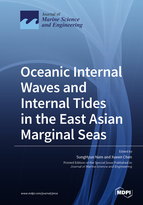Oceanic Internal Waves and Internal Tides in the East Asian Marginal Seas
A special issue of Journal of Marine Science and Engineering (ISSN 2077-1312). This special issue belongs to the section "Physical Oceanography".
Deadline for manuscript submissions: closed (25 December 2021) | Viewed by 21869
Special Issue Editors
Interests: observational oceanography; oceanic internal waves; ocean circulation; mesoscale and submesoscale variability; climate variability; ocean observation
Interests: coastal dynamics modelling; ecosystem modelling; data assimilation; sea-test technologies’ developing for oceanic instruments; internal waves and ocean mixing
Special Issue Information
Dear Colleagues,
Oceanic internal waves (IWs) at frequencies from local inertial (e.g., near-inertial internal waves) to buoyancy frequencies (nonlinear internal waves or internal solitary waves) sometimes including diurnal and semidiurnal tidal frequencies play an important role in redistributing heat, momentum, materials, and energy via turbulent mixing. The IWs are ubiquitously found in many seas, including East Asian marginal seas (South China Sea, East China Sea, Yellow Sea, East Sea or Japan Sea, Okhotsk Sea), significantly affecting underwater acoustics, coastal and offshore engineering, submarine navigation, biological productivity, and the local and global climate. Despite decades of study, on the IWs in some regions, our understanding of the IWs in the East Asian marginal seas is still in a primitive state and the mechanisms underlying every stage (generation, propagation, evolution, and dissipation) of IWs are not always clear. This Special Issue invites papers related to all fields of both low- and high-frequency IW studies in the specified region, including remote sensing, in situ observations, theories, or numerical models.
Prof. Dr. SungHyun NamProf. Dr. Xueen Chen
Guest Editors
Manuscript Submission Information
Manuscripts should be submitted online at www.mdpi.com by registering and logging in to this website. Once you are registered, click here to go to the submission form. Manuscripts can be submitted until the deadline. All submissions that pass pre-check are peer-reviewed. Accepted papers will be published continuously in the journal (as soon as accepted) and will be listed together on the special issue website. Research articles, review articles as well as short communications are invited. For planned papers, a title and short abstract (about 100 words) can be sent to the Editorial Office for announcement on this website.
Submitted manuscripts should not have been published previously, nor be under consideration for publication elsewhere (except conference proceedings papers). All manuscripts are thoroughly refereed through a single-blind peer-review process. A guide for authors and other relevant information for submission of manuscripts is available on the Instructions for Authors page. Journal of Marine Science and Engineering is an international peer-reviewed open access monthly journal published by MDPI.
Please visit the Instructions for Authors page before submitting a manuscript. The Article Processing Charge (APC) for publication in this open access journal is 2600 CHF (Swiss Francs). Submitted papers should be well formatted and use good English. Authors may use MDPI's English editing service prior to publication or during author revisions.
Keywords
- East Asian marginal seas
- internal waves
- internal tides
- near-inertial waves
- nonlinear internal waves
- internal solitary waves.







